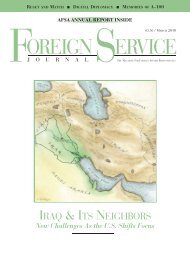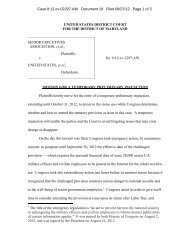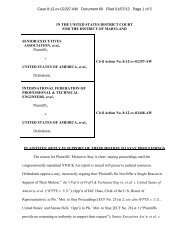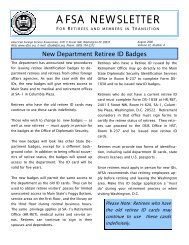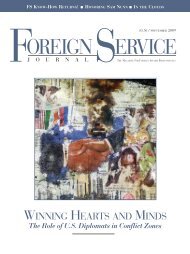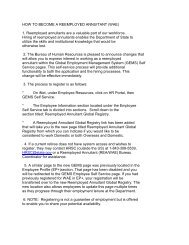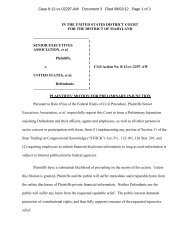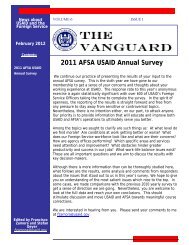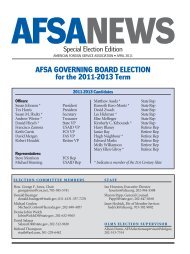F OCUS - American Foreign Service Association
F OCUS - American Foreign Service Association
F OCUS - American Foreign Service Association
You also want an ePaper? Increase the reach of your titles
YUMPU automatically turns print PDFs into web optimized ePapers that Google loves.
F O C U S<br />
aligned — to declare an official end to the ideological division<br />
that defined the Cold War. The Charter of Paris for<br />
a New Europe (November 1990) proclaimed nothing less<br />
than “a new era of democracy, peace and unity.”<br />
Many well-informed observers on both sides of the Atlantic<br />
predicted that NATO would quickly be supplanted by<br />
commercial relations, the rise of “soft power” and a reinvigorated<br />
United Nations Security Council. Yet throughout<br />
the 1990s, two persistent realities would sustain, indeed increase,<br />
the need for the Alliance: the demand for an effective<br />
international structure to plan and execute multinational<br />
military operations (and the inability of other organizations<br />
to play this role); and the aspiration of the<br />
emerging democratic states to the east to join the Alliance,<br />
even as some on the inside were questioning its relevance.<br />
Understanding of the continued operational need for<br />
NATO would come at a frightful cost. In the former Yugoslavia,<br />
long-suppressed ethnic tensions boiled over into<br />
violence, and the international community would see<br />
much blood spilled before turning to NATO as the only<br />
structure capable of restoring order and putting the region<br />
on the road to recovery. The Balkan experience would introduce<br />
NATO for the first time to “out of area” operations,<br />
and transform the Alliance from a static territorial<br />
defense pact to a much more flexible instrument of peacebuilding<br />
and crisis management.<br />
Meanwhile, the Alliance’s strategic decision to maintain<br />
an “open door” to membership for its neighbors, while<br />
linking NATO accession to demonstrable progress in military,<br />
economic and political reform, played a key role in<br />
managing a potentially dangerous period of transition and<br />
building a solid foundation for the peaceful, democratic<br />
development of Eastern Europe. For those not yet ready<br />
Paul Fritch is director of the Office of the Secretary General<br />
of the Organization for Security and Cooperation in<br />
Europe. From 2001 to 2007, he served on the NATO International<br />
Secretariat, where he headed the Russia and<br />
Ukraine Relations Section of the Political Affairs and Security<br />
Policy Division. Prior to these international positions,<br />
his <strong>Foreign</strong> <strong>Service</strong> career included assignments in<br />
India, Germany, Russia and the Bureau of European Affairs,<br />
where he worked on the adaptation of the Treaty on<br />
Conventional Armed Forces in Europe.<br />
The views expressed in the article are his own, and do<br />
not represent the official policy of the U.S. government,<br />
NATO or the OSCE.<br />
to join the Alliance, new forms of structured dialogue and<br />
practical cooperation were launched.<br />
An Elusive Partnership<br />
So far, so good. But what of those who were not interested<br />
in joining NATO, and were unwilling to subject<br />
themselves to its political and military “standards”? What<br />
of those who were uncomfortable with NATO’s new “expeditionary”<br />
role? What, in a word, of Russia?<br />
In the early days of the post–Cold War period, NATO<br />
saw enlargement and NATO-Russia partnership as mutually<br />
reinforcing, equally important objectives. The Allies<br />
firmly rejected the notion of a Russian veto over membership<br />
decisions, but were willing to work with Moscow to<br />
address specific Russian concerns over the impact of NATO<br />
enlargement, including through providing assurances with<br />
regard to the Alliance’s nuclear and conventional force posture.<br />
The 1997 NATO-Russia Founding Act established a<br />
standing forum for NATO-Russia consultation, as well as<br />
an ambitious common agenda and a number of specific<br />
commitments to military restraint. This political rapprochement<br />
was matched by impressive cooperation on the<br />
ground, in the form of Russian troops serving in the NATOled<br />
peace support mission in Bosnia and Herzegovina. In<br />
fact, until 2003, Russia was the largest non-NATO troop<br />
contributor to NATO-led operations.<br />
Yet the NATO-Russia relationship remained fragile. In<br />
1999, the Kosovo crisis introduced the Alliance, just three<br />
years into its new peacebuilding role, to actual combat operations.<br />
As NATO crossed this Rubicon on the basis of a<br />
simple consensus of the North Atlantic Council rather than<br />
an explicit U.N. mandate, Moscow saw another important<br />
symbol of its great-power status — its Security Council<br />
veto — degraded. Russian representatives walked out of<br />
the NATO-Russia Permanent Joint Council, and meaningful<br />
partnership seemed a distant prospect.<br />
It was in this context that my own career on the NATO<br />
International Staff began. I did not know it then, but my<br />
first day of work at NATO headquarters — Sept. 10, 2001<br />
— would be remembered by many as the last day of the<br />
“post–Cold War period.”<br />
NATO responded to the 9/11 terrorist attacks by invoking<br />
— for the first time ever — the collective defense<br />
provisions of the North Atlantic Treaty (Article 5). Within<br />
a year, NATO had launched its most ambitious military operation<br />
yet — the International Security Assistance Force<br />
in Afghanistan. Long-neglected elements of NATO’s<br />
A P R I L 2 0 0 9 / F O R E I G N S E R V I C E J O U R N A L 29



